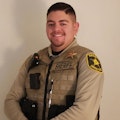Cold Case Resolutions #10: Prejudice vs. Evidence
I bring you this column out of my pure fascination with cold cases, forensics, police work, and all things mysterious. As an active duty Police Officer, I hold an interest in all cases especially those that bring justice to light in the end. It has long been said one should not forget where they came from, and the same should be said of forensics. It is not uncommon to find a digital fingerprint scanner in any given police station, capturing high resolution images and instantly thrusting them into state and federal databases. A gun can't be fired anymore without leaving experts a plethora of evidence. Private labs are making incredible strides with new methods of DNA sequencing, regularly cracking long dormant cases. However, before these methods were accepted, there was skepticism. Was this nonsense, or the cutting edge of forensics? Though this case wasn't necessarily cold, it spotlights the genesis of one of the tent-poles of modern forensics, opening the door for countless cases to be solved throughout the next century.
Braintree Massachusetts, April 15, 1920. A security guard and a paymaster are transporting the Slater-Morrill Shoe Company's payroll to the factory. Two armed men ambush them, shooting the guard four times, and the paymaster twice, all with .32 caliber rounds. The coroner's report determined because of the narrow rifling and twist found on five of the six rounds, they must have come from a Savage Model 1907 semi-automatic pistol. The shooters took the security guard's .38 revolver, picked up the cash boxes, and loaded them into their getaway car, occupied by several accomplices. In December of the previous year a similar robbery of a shoe company was attempted in the nearby town of Bridgewater Massachusetts. The men involved were identified as Italian, leading police to believe they were part of a group of Italian Anarchists operating in Massachusetts, trying to gather funds for their propaganda and other radical activities. This of course made the anarchists prime suspects for the Braintree robbery.
The day of the robbery, an anarchist named Ferruccio Coacci was scheduled to report for deportation back to Italy, but claimed he couldn't make it because his wife was sick. Federal Immigration Services asked Bridgewater Police to check on Coacci and the legitimacy of his wife;s illness. Police discovered Mrs. Coacci was not ill. Coacci and his family left for Italy of their own accord on April 18th. Police learned Coacci was a former employee of the Slater-Morrill Shoe Company, as well as the other victimized shoe company in Braintree. Police later spoke with Mario Buda, Coacci's close friend and fellow anarchist. Buda lived with Coacci and his family and allowed them to search the residence. Officers found manufacturers diagrams for a Savage Model 1907, and Buda admitted Coacci did carry that type of gun.
Officers would later locate the getaway vehicle, abandoned, with a separate set of tire tracks nearby, indicating the men switched vehicles after the robbery. When police learned Buda's car was at a mechanic's garage for repairs, they instructed the mechanic to call Police if anyone showed up to retrieve the car. On May 5th, Police were notified a group of men, including Buda arrived for the vehicle. Police responded and were able to track down two men leaving in a streetcar. The two men, Niccola Sacco and Bartolomeo Vanzetti, were found in possession of a .32 Colt pistol with several rounds matching those used in the robbery, a .38 revolver, much like the one stolen from the murdered guard, and anarchist literature. Sacco and Vanzetti were charged with the Braintree murders. During the trials, key mistakes by the defense left the door open for the prosecution to paint them as radical anarchist foreigners. The prosecution also presented evidence which showed the round taken from the scene which was not from a Savage Model 1907 (known as Bullet III), was fired from Sacco's Colt pistol. The two men were convicted after a few hours of jury deliberation, and sentenced to death.
The defense insisted on a new trial, citing conflicting statements from witnesses, prejudicial comments made by the jury foreman, inconsistencies in the ballistic evidence, and anti-radical rhetoric by the judge, who went as far as to tell reporters “I'll show them that no long-haired anarchist from California can run this court!”, in reference to Sacco's attorney. The defense maintained prejudices against the men's nationality and ideology plaid a major role in their conviction. They also presented a new affidavit from one of the ballistics experts used in the case admitting he could not positively say Bullet III came from Sacco's gun. The court denied these motions, and this decision was held by the Massachusetts Supreme Judicial Court.
In 1925, a man by the name of Celestino Medeiros confessed to carrying out the robbery along with gang leader Joe Morelli, who strongly resembled Sacco. Medeiros was on trial for a separate murder at the time and was later convicted. 1927 this evidence was presented to the Supreme Judicial Court in hopes of halting the upcoming executions of Sacco and Vanzetti. The Court agreed this was valid evidence, however it did not warrant a new trial. In April of that year, thanks to the attention the case had garnered, Massachusetts Governor Alvin Fuller postponed the executions while a committee looked into the case.
The committee enlisted the help of forensic ballistics pioneer, Calvin Goddard. Given the conflicting statements given during and after trial about Bullet III coming from Sacco's gun, Goddard compared it with test rounds fired from Sacco's Colt pistol. In the presence of an expert from the defense Goddard used a newly invented comparison microscope to examine bullets and shell casings from the Sacco's gun and those found at the scene. By this point ballistics experts were aware the random imperfections from a gun's barrel and firing pin, be they from manufacture or usage, were transferred onto bullets and shell casings respectively. These tiny imperfections could be viewed under a microscope, however the examiner would need to remember these markings as best they could when switching between specimens for comparison. With the use of the comparison microscope, both items could be viewed side by side in real time. Using this technology, Goddard found Bullet III and shell casings from the scene did indeed come from Sacco's gun. The defense expert viewed the findings as well and agreed the rounds were fired from the same gun.
With this information, the committee found there was sufficient evidence to uphold the convictions of Sacco and Vanzetti. Both men were executed by electrocution in August of 1927. Sadly, there are still questions regarding the men's innocence. It appears they were not given fair treatment and important facts, some of which may have exonerated them, were overlooked or ignored. There are even suggestions from some that the bullets and casings provided to Goddard were not the original items from the scene. Regardless, those items were compared to the rounds and casings fired by Goddard himself, and were deemed a match. His findings were retested on multiple occasions, as recently as 1983, and were found to be accurate each time. The guilt of Sacco and Vanzetti may be questionable, and their executions may have been unjust, but what we do know for sure is while people often lie, the evidence never will.
About the Author

Officer Brendan Rodela, Contributing Editor
Brendan Rodela is a Sergeant for the Lincoln County (NM) Sheriff's Office. He holds a degree in Criminal Justice and is a certified instructor with specialized training in Domestic Violence and Interactions with Persons with Mental Impairments.
